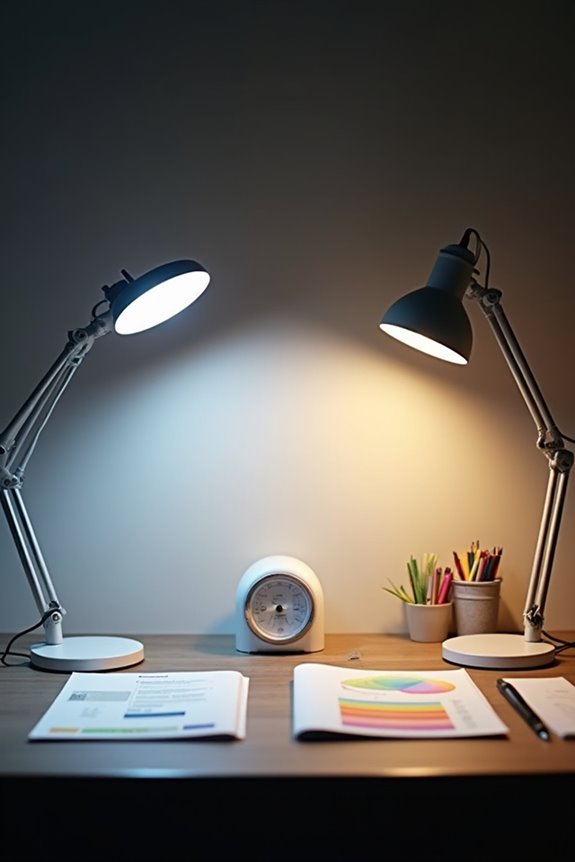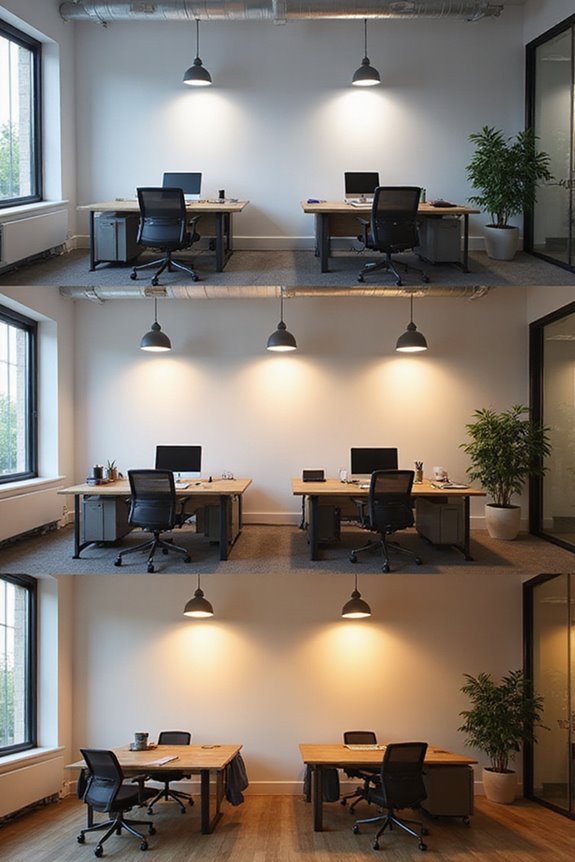LED desk lamps are better than fluorescent ones for several reasons. They are up to 80% more energy-efficient, which means lower electricity costs. Unlike fluorescents, LEDs don’t contain hazardous materials like mercury, making them safer. Additionally, LEDs can last up to 50,000 hours, reducing maintenance demands. They also provide better light quality, reducing eye strain. As you consider your options, you’ll discover more benefits that make LEDs a wise choice for any workspace.
Key Takeaways
- LEDs are up to 80% more energy-efficient than fluorescent lamps, leading to lower energy bills.
- LED desk lamps have a lifespan of up to 50,000 hours, significantly reducing replacement frequency.
- LEDs provide better light quality with less flicker, enhancing visual comfort and reducing eye strain.
- Unlike fluorescents, LEDs contain no hazardous materials like mercury, making them safer for the environment.
- The sleek and modern design of LED lamps appeals to contemporary aesthetics, unlike less visually appealing fluorescent options.
Energy Efficiency Comparison
When considering lighting options, it is crucial to understand the significant differences in energy efficiency between LED and fluorescent lamps. LEDs are up to 44% more efficient than 4-foot fluorescent tubes, and they can be as much as 80% more efficient overall. This means that LEDs consume 75% less energy while providing comparable light output.
In terms of performance, LEDs convert an impressive 95% of their energy into light, while fluorescent lights require more power for the same brightness. Additionally, LEDs maintain their efficiency even at low dimming levels, contributing to reduced energy consumption and lower operational costs. Overall, choosing LED lamps can lead to significant energy cost savings, making them a smart choice for lighting your space effectively.
Environmental Impact of Lighting Choices
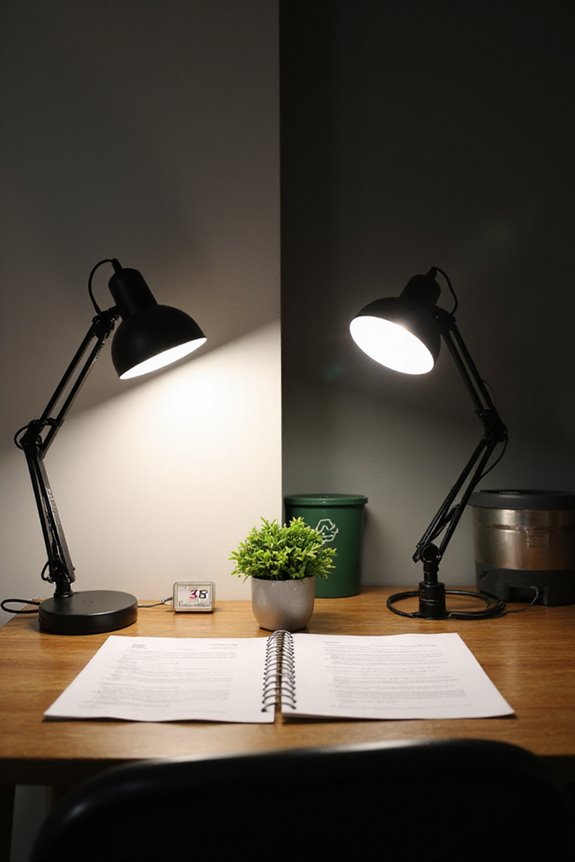
While choosing lighting options for your space, it’s important to contemplate the broader environmental implications of your decisions. The shift to LED desk lamps stands out due to their minimal ecological footprint. Unlike fluorescent lamps, LEDs lack hazardous materials such as mercury, making them a safer choice. Their energy-efficient design not only reduces greenhouse gas emissions but also lowers air pollution, contributing to cleaner air. Additionally, LEDs require fewer raw materials for production, supporting sustainable practices and reducing waste. With a longer lifespan, they decrease the frequency of replacements, further minimizing waste. Ultimately, opting for LED lighting helps create a more sustainable future, aligning your choices with environmentally responsible practices while enjoying the benefits of enhanced efficiency. Moreover, LEDs can last over 15,000 hours, ensuring long-term sustainability in your lighting choices.
Durability and Lifespan of LEDs vs. Fluorescents
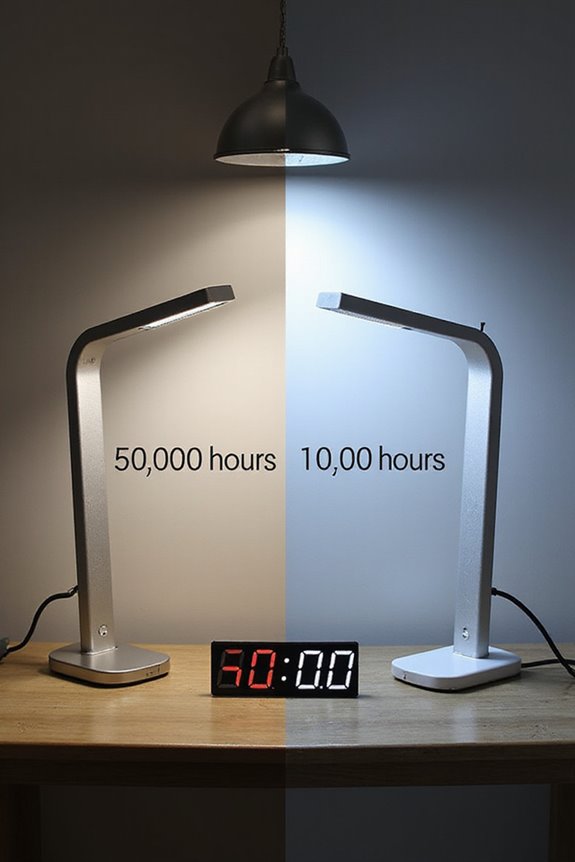
Understanding the durability and lifespan of lighting options is essential for making informed choices. When comparing LED lifespan to fluorescent durability, LEDs shine with an impressive lifespan of up to 50,000 hours, and advanced models can even reach 200,000 hours. In contrast, fluorescent bulbs typically last only 6,000 to 15,000 hours.
LEDs gradually dim over time instead of failing suddenly, ensuring consistent performance. They also withstand varying electrical conditions and environmental factors better than fluorescents, contributing to their overall durability. Additionally, with less frequent replacements needed, the long lifespan of LEDs translates to reduced maintenance. Ultimately, for those seeking longevity and reliability in lighting, LEDs prove to be the superior choice over fluorescent options.
Maintenance Requirements for Desk Lamps
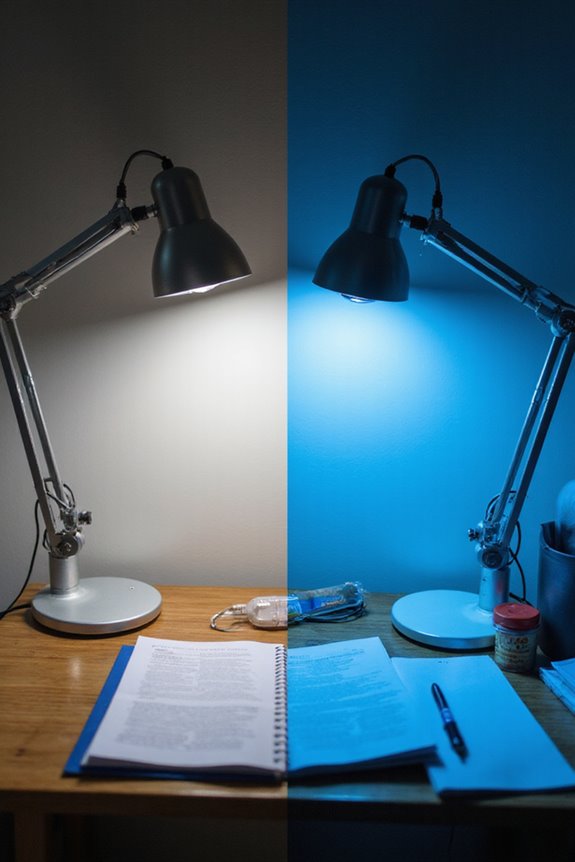
Maintaining desk lamps is essential for guaranteeing their efficiency and longevity. Here are some effective maintenance tips to keep your lamp in top shape.
- Regular Cleaning: Dust your lamp weekly with a soft, dry cloth to prevent buildup. For stubborn dirt, use a slightly damp cloth with mild detergent, guaranteeing not to immerse any part in water.
- Ventilation: Guarantee proper airflow around the lamp to prevent overheating.
- Electrical Safety: Always unplug the lamp before cleaning, and make sure all parts are completely dry before reassembling.
- Inspection: Regularly inspect the lamp for signs of wear or damage.
Dimming Performance and Usability
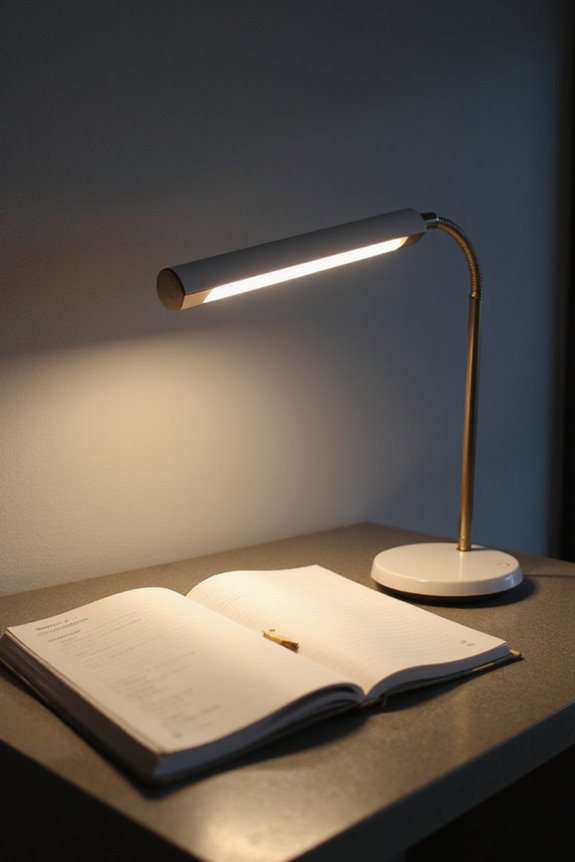
When it comes to desk lamps, the ability to adjust brightness can greatly impact your overall experience. LED desk lamps excel in dimming flexibility, allowing for a smoother and more consistent dimming range compared to fluorescent options. They can dim down to lower light levels without flickering, which is often a problem with older fluorescent lamps.
Moreover, LEDs achieve full brightness almost instantly, enhancing user satisfaction during tasks. This quick response is essential for productivity, especially during long study sessions. Additionally, LED lamps typically come with built-in dimmers or are compatible with standard dimmers, making them user-friendly. In contrast, retrofitting fluorescent fixtures to achieve similar dimming capabilities often requires extra hardware, complicating usability. Furthermore, the energy efficiency ratings of LED lamps can contribute to lower electricity costs over time, making them a more sustainable choice.
Cost Analysis: Initial Investment vs. Long-Term Savings
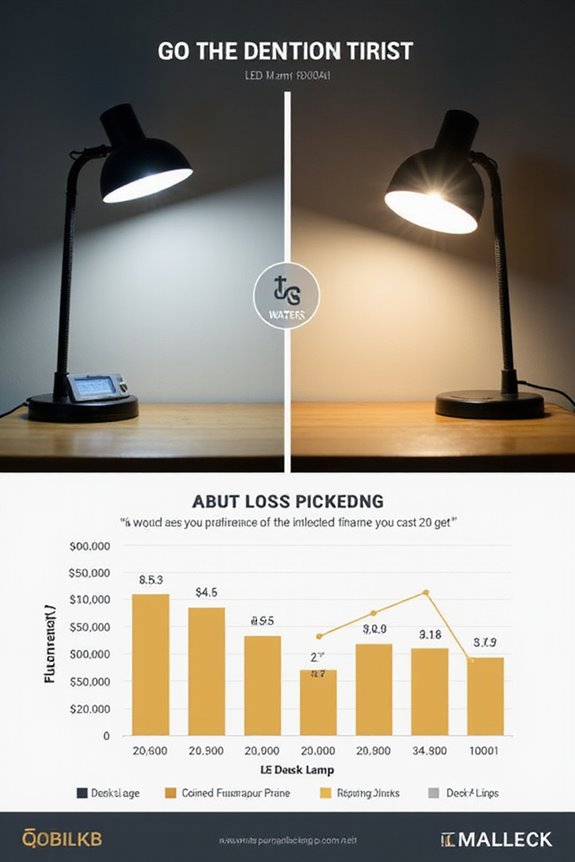
While the initial cost of LED desk lamps is generally higher than that of fluorescent lamps, the comparison shifts dramatically when considering long-term savings. LED lamps typically range from $5 to $20, while fluorescent options fall between $2 and $5. However, their longer lifespan and energy efficiency mean that the initial costs of LEDs are offset by significant long-term benefits. LEDs consume 40% to 60% less electricity, leading to substantial savings on utility bills over time. Additionally, the reduced frequency of replacements further enhances their value. Essentially, while LEDs may require a higher upfront investment, their cumulative cost reduction and improved ROI ultimately make them a smarter financial choice for the future.
Health Considerations for Eye Comfort
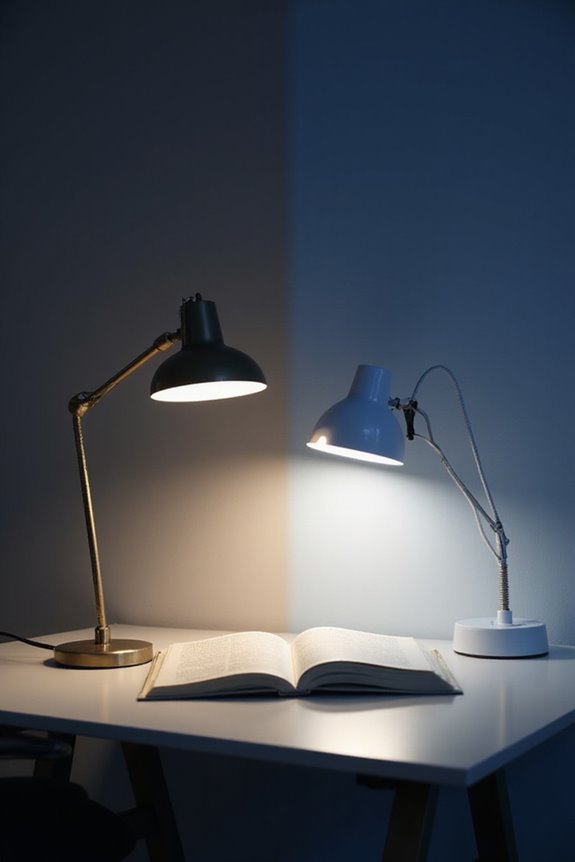
As we consider the impact of lighting on our eye health, it’s vital to recognize how different types of desk lamps can influence our comfort and well-being. LED desk lamps stand out for their ability to reduce eye strain considerably. Unlike fluorescent lights, which often flicker and contribute to discomfort, LEDs provide a steady light output. This consistency enhances visual comfort, making it easier to focus for extended periods. Additionally, the adjustable brightness and color temperature options of LEDs allow for a tailored lighting experience. Warm white LEDs are particularly recommended, as they support eye health better than cooler variants. Ultimately, choosing the right desk lamp is essential for maintaining eye comfort and minimizing long-term health impacts.
Safety Aspects of LED and Fluorescent Lighting
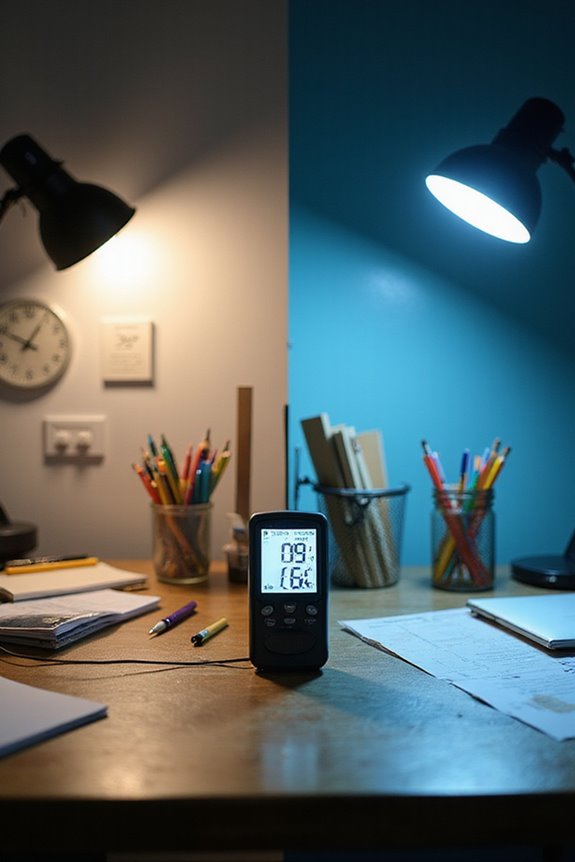
Choosing the right lighting for your workspace isn’t just about comfort; safety is a significant factor as well. When comparing LED and fluorescent lighting, LEDs have clear advantages. Unlike fluorescents, LEDs contain no mercury, eliminating risks associated with contamination and complex disposal. This compliance with safety regulations enhances accident prevention, especially in crowded environments, as LEDs operate at lower temperatures and are less prone to breaking.
Furthermore, LEDs use lower voltage, reducing the risk of electric shock during maintenance. Their durability means they’re less likely to shatter, making them safer for high-traffic areas. Overall, LEDs present a more secure option for your workspace, minimizing health and environmental risks while ensuring adherence to necessary safety standards.
Aesthetic and Ambiance Differences
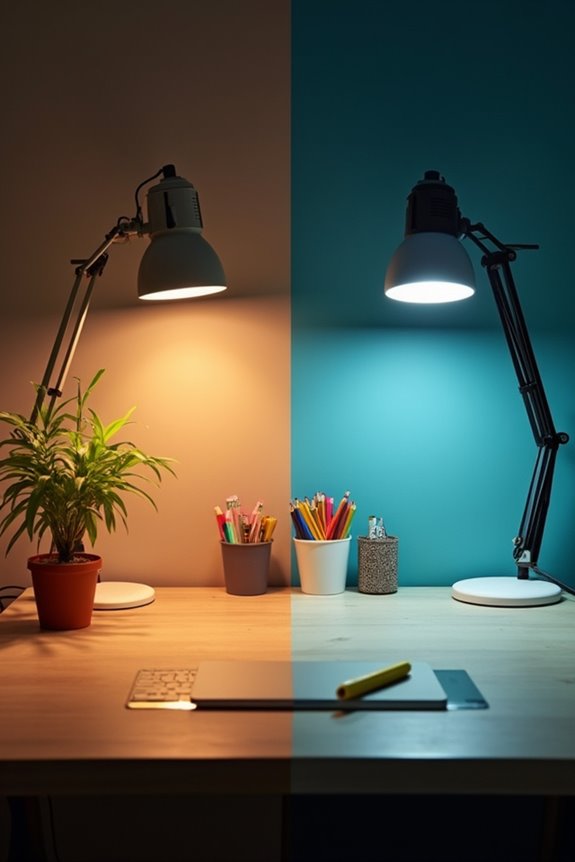
When considering the aesthetic qualities of LED desk lamps versus fluorescent options, it’s clear that LEDs offer a broader range of design possibilities. Their modern styles, from minimalist to industrial, align well with current design trends, making them suitable for various decor themes. I appreciate the variety in colors and finishes, like black and silver, which enhances the visual appeal of my workspace.
Additionally, LED lamps provide customizable mood lighting, allowing me to adjust brightness and color temperature based on my needs. This flexibility not only supports focus but also creates a relaxing atmosphere when needed. Overall, the sleek profiles and eco-friendly materials of LED lamps contribute to a contemporary aesthetic that fluorescent lamps simply can’t match.
Frequently Asked Questions
Can LED Desk Lamps Be Used With Existing Fluorescent Fixtures?
Imagine a chameleon, adapting seamlessly to its surroundings. That’s how LED compatibility works with fluorescent fixtures. Sometimes, fixture modifications are needed, but with the right approach, you can breathe new life into your lighting.
Are There Different Color Temperatures Available for LED Desk Lamps?
I love the color temperature options available in LED desk lamps. With a wide LED light spectrum, I can adjust between warm and cool tones, enhancing my mood and productivity for different tasks throughout the day.
Do LED Desk Lamps Produce Heat Compared to Fluorescent Lamps?
You know, when it comes to heat output, LED desk lamps are like a cool breeze compared to fluorescent ones. Their energy efficiency means they produce much less heat, keeping things comfortable during long hours of use.
How Do I Properly Dispose of Old Fluorescent Lamps?
When I dispose of old fluorescent lamps, I always check local recycling options and follow disposal guidelines. It’s essential to use leak-proof containers and never toss them in regular trash to avoid mercury hazards.
Can LED Desk Lamps Be Dimmed Using Standard Dimmer Switches?
I’ve found that using standard dimmers with LED desk lamps can be tricky. They often lack dimming compatibility, leading to flickering. It’s best to opt for specialized dimmers designed for LEDs to guarantee smooth operation.

